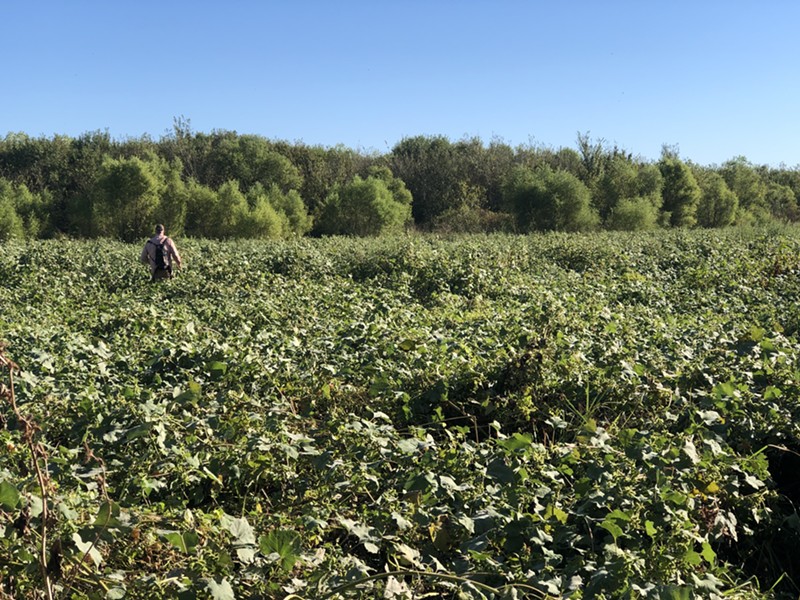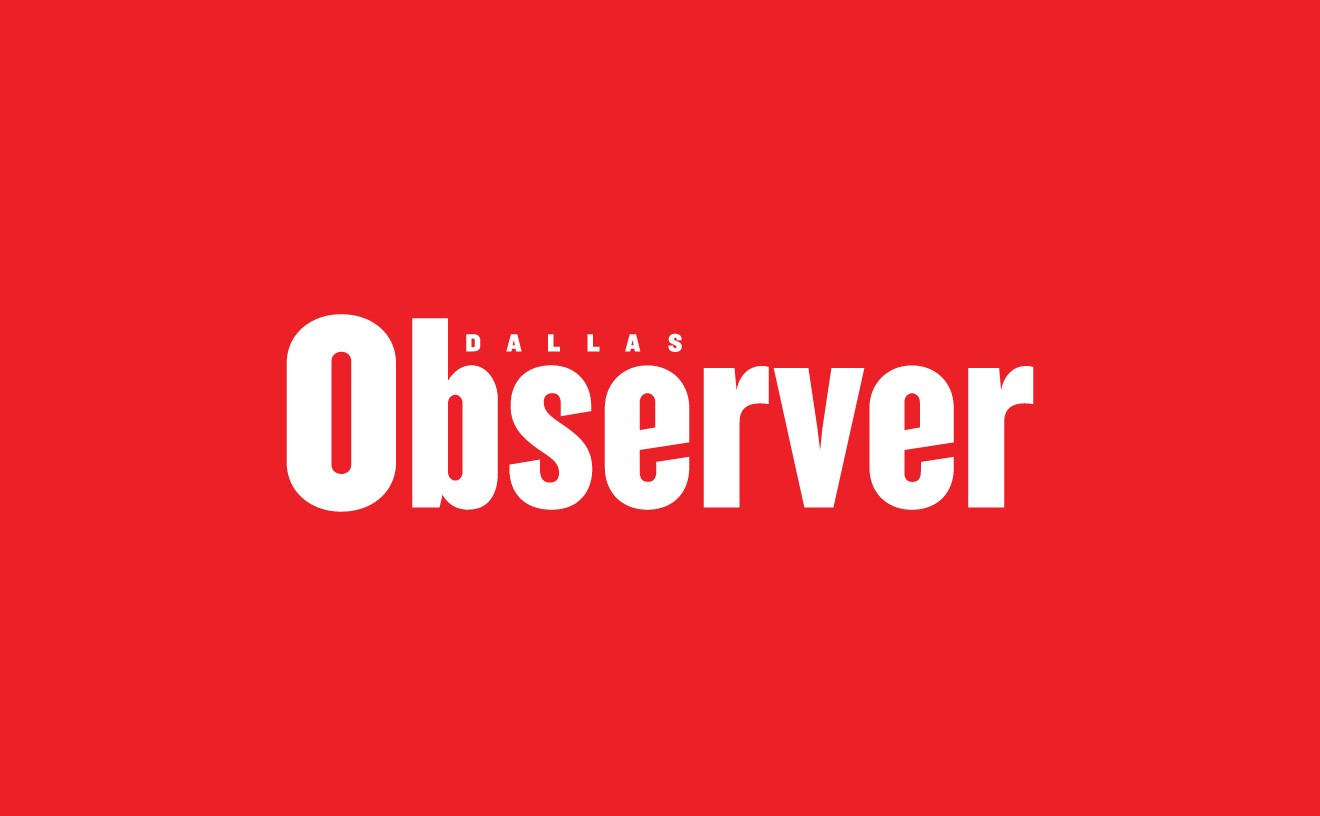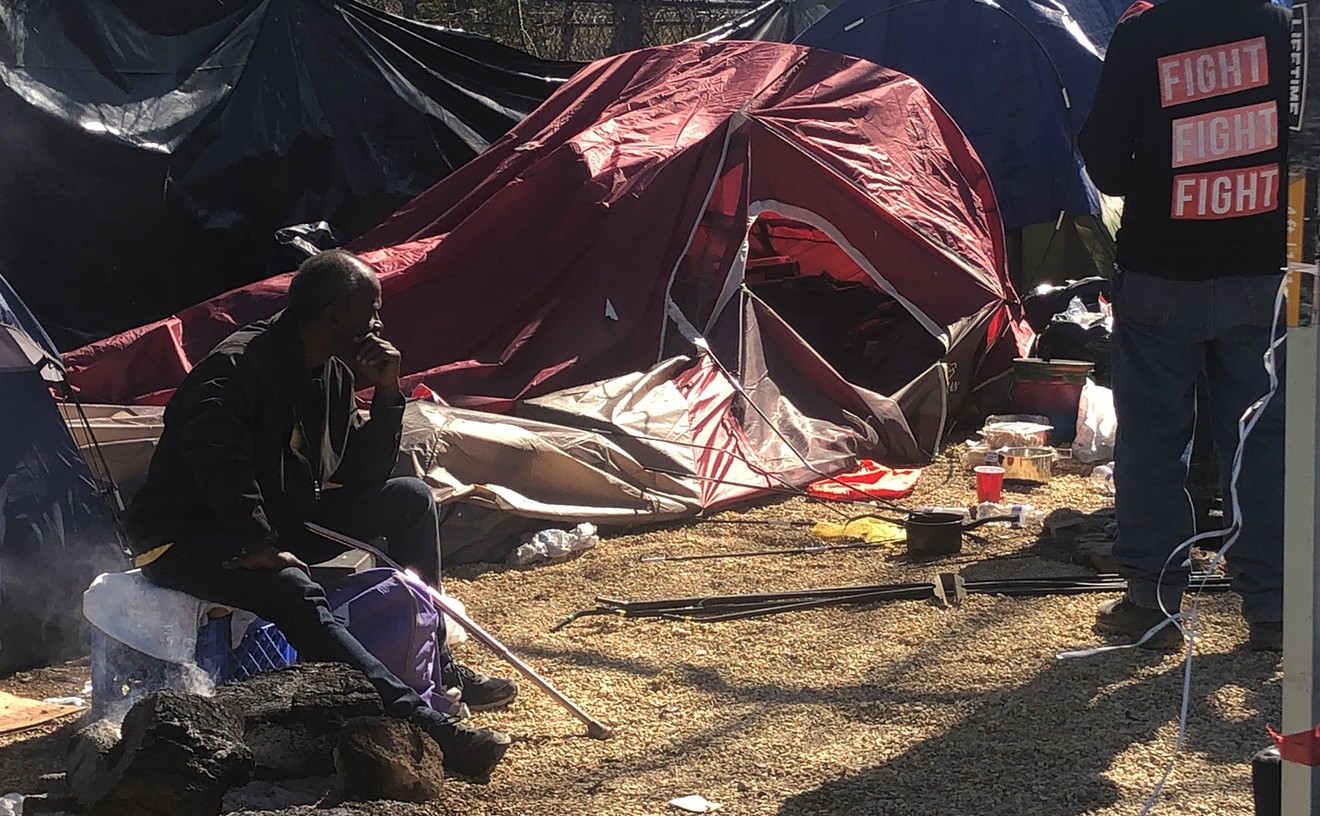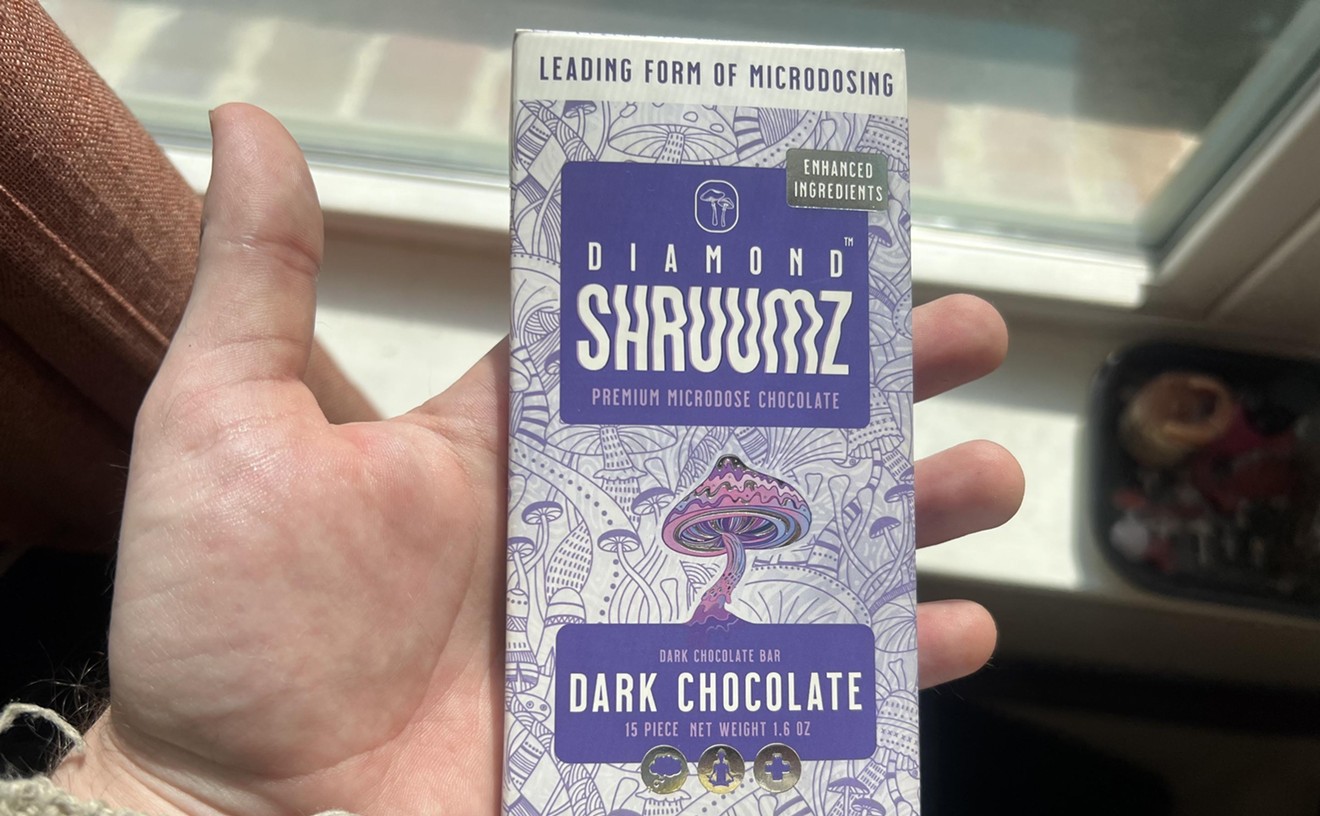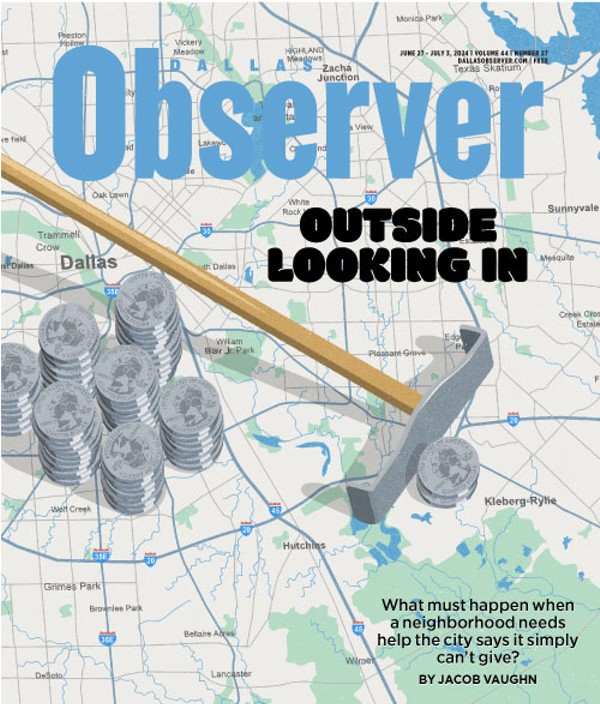Leaves, tree branches and thick weeds crunched underneath Sandifer’s feet with every step he took on his way to a hidden Dallas gem: Lemmon Lake. Except, it’s not really a lake these days. There was a breach in the levee that held the lake together a few years ago. What’s left is more of a meadow, where nature has been allowed to take over. That late September day in the Trinity Forest, Sandifer was headed to where the levee broke.
No one really knows how the lake was originally formed, he said. It may have been born from an old channel of the Trinity River that splintered off after a flood. But the area is a relic of Dallas history and emblematic of inequity in the city.
Archeological sites are littered throughout the area. Some date back to the late archaic, which is a thousand years ago, when Native Americans occupied the land. They hunted bison and deer mostly, leaving behind bones that can still be seen on walks through the forest today.
The concrete trail was built on an old ranch road in 2008-2009. There are little fishing shacks along the trail, leftovers from an old fishing and hunting club. Some of the trail is yet to be built, Sandifer said. “There’s various sections up near Joppa on the other side of Loop 12 that were promised to have been finished by now, but weren’t,” he said.
“I always tell people ‘If you want to see environmental injustice or that kind of palette of problems that exist in the city of Dallas [come here],’” Sandifer said. “I know if this was north of I-30, it would have been finished by now.”
A lot of promises made for the area were never fulfilled. Dating back to the ’60s, different groups would tell area residents: “‘Look, we’re going to screw up a bunch of stuff up here on the levees near downtown, but we’re going to fix Lemmon Lake,’” Sandifer explained. “‘We’re going to do a lot of work on it. We’re going to make it to where it’s kind of a sportsman's paradise again.’”
That never happened.
In the ’80s, some had the idea to revitalize the lake and make it the White Rock Lake of southern Dallas. “It was going to become a place for recreation and family gatherings and stuff,” Sandifer said.
That didn’t happen either.
Now, he said, “To turn it back to a lake would take a lot of money.” It could cost a couple million dollars, he said, “and what else could you do with a couple million dollars in this neighborhood other than fix an old lake? On the needs list, I think it would probably be pretty far down.”
After all, the area is plagued by issues like high crime, food insecurity and a lack of economic growth, all of which could use such an investment.
Lemmon Lake's story began in May 1897 when it was purchased for a fishing and hunting club known as the Trinity River Rod and Gun Club.
In the late 1800s, hunting and fishing clubs were a trend and many were created along the Trinity River in Dallas. The Trinity River Rod and Gun Club was created as a hunting and fishing paradise before the car was brought to North Texas.
An old Dallas Morning News clipping about the club purchase at the time read: "The Trinity Rod and Gun Club, recently organized, has just purchased 300 acres of land, including and surrounding Miller's lake, close to the river, eight miles south of Dallas. Its members claim that by this purchase they have obtained possession of one of the finest hunting and fishing tracts in the state. There is a lake of 200 acres in the tract and it is proposed to develop it to the utmost.""I know if this was north of I-30, it would have been finished by now." - Ben Sandifer
tweet this
People liked the club because it was close to downtown Dallas. You could travel there by horse or by trains, Sandifer said. A set of train tracks run past Joppa Preserve off of River Oaks Road, and there used to be a stop there called Lakewood where well-healed people could stop and be right at the club.
At the entrance of Joppa Preserve, you can see where the old fishing and hunting club used to stand. Trees are scattered throughout the area now. Some of the post oak and hickory trees predate European settlement of Dallas. “So, these are ancient trees,” Sandifer said. Before the club was there, Dallas had its first Juneteenth celebration with freed slaves at the site.
There have been many events at Joppa Preserve since. Claudia Fowler, a former Joppa resident, has only walked the trails at the preserve once because she said she's afraid of snakes, but she's helped organize many events at the park. The most popular, Fowler said, was Joppa Juneteenth.
The club went defunct in the 1960s-70s.
But in 1980, a local philanthropist named Bill Barrett challenged Dallas County with money to purchase the roughly 250 acres that would eventually become the Joppa Preserve. The deal included Lemmon Lake and Little Lemmon Lake.
Barrett wanted to turn it into a southern White Rock Lake. The money didn’t come from the most conventional place. “If you drank Coors beer in the 1970s, you helped pay for this,” Sandifer said. Barrett owned a place called Willow Distribution and was the sole provider of Coors beer back in the ’70s. “That’s somebody’s beer money that paid for Lemmon Lake,” Sandifer said.
There was a pitch around 2001-2005 from the Army Corps of Engineers to fix the levee and bisect Lemmon Lake to turn it into two lakes. It would have water control features to attract the most wildlife possible. The lake was also high on the list of places to build the Trinity River Audubon Center, but those plans didn’t pan out.
One of the bad things that happened to Lemmon Lake over the years was that it was cut off from its water supply when the Trinity Trail Phase One was built in 2008-2009. It forever changed the hydrology of the lake, Sandifer said. The move starved the lake from its water source, which was a small creek called Cob’s Ditch that runs between Little Lemmon Lake and Lemmon Lake.
The lake started to go dry during the summer months and would really only fill up during big flooding events. The other thing that happened with Lemmon Lake is the Trinity River channel grew wider and deeper due to urbanization upstream, so the river carries a lot more water than it used to. This is because there are more non-porous surfaces like parking lots upstream with urban development, which sends rainwater runoff rushing into streams rather than soaking into the ground.
As a result, there’s a lot of large-scale erosion along the Trinity River. One of the things that was damaged by the erosion and has not seen any kind of repair or maintenance work is the Lemmon Lake levee in one area, which has been failing for about the last 10 years. Eventually, this part of the levee just gave out.
Some of the first times Sandifer went to Joppa Preserve, he was hesitant to go off the trail because he doesn’t particularly like snakes and some other animals he’d find in the forest.
But he eventually mustered up the courage to go inside. “It was a super beautiful place. I’m a native of Dallas and had never seen anything like it,” Sandifer said. “It looked like I was along the Gulf Coast or in Louisiana or in South America with some of the stuff I saw.”
Once he found a way inside and access points for the lake, he started going there every evening after work. “It was so cool. I would see different things every time. I would see coyotes or bobcats, deer, that kind of thing,” he said.
That day this September, big stickers called cockleburs were his enemy for the day. They gripped his clothes as he made his way to the levee breach, balloon vine scattered all around. Opening one of them up, you could see the seeds: black on one end and white on the other, resembling a yin yang.
Along his trek to the levee, Sandifer came across an aquifer-fed pond that he often visits. On the shore of the pond is an old wood structure that’s fallen apart over the years. It was a pump house built around the time of World War I. The pump house would help supply water to a nearby farm.
The farm itself, it’s thought, was originally run and leased by Japanese immigrants who came here during a big immigration push in the 1920s after World War I, Sandifer said. He said it’s thought that the Japanese family was forced to sell their land and their farm at the beginning of World War II because of their heritage.
“It’s kind of sad about what happened to this land and how someone had their land taken away from them, people that were American citizens, but were Japanese by birth in this area,” he said. “So, it’s kind of a dark tale about a forgotten piece of Dallas history.”
The structure was still intact when Sandifer first started going out to Lemmon Lake. “It had a metal tin roof to it,” he said. “I’ve been down here a couple times when storms were blowing up and it’s the only shelter out here really to get in a dry spot.” Out on the bike trail, riders used to be able to hear the tin roof rattling in the wind. “It was kind of a ghostly sound coming from this thing,” he said.
Eventually, he made it to a shoreline of the Trinity River. “As far as rivers go in Texas, it might not be the cleanest. Maybe it’s one of the dirtiest, but it is our river,” he said.
“It’s important to Texans.” He said it’s the most important river for Texas because it supplies our drinking, as well as the water supply for the Houston area. The water from the Trinity River is also important to the petrochemical industry.
Then, in the Trinity Bay, it turns into brackish water that fuels a lot of the seafood supply for the Gulf of Mexico. “It’s a polluted and impaired water body. So, the fish are too toxic to eat. You shouldn’t drink the water, you shouldn’t even swim in it most of the time,” he said. “You shouldn’t even touch it in some extreme examples.” But it cleans itself out. “By the time it gets to Lake Livingston, which is north of Houston, the water in the river becomes clean enough for people to eat the fish and swim in Lake Livingston,” he said.
After nearly two hours of toughing it through the harsh terrain of the Great Trinity Forest, Sandifer made it to the breach in the levee. It’s a mess of knotted-up concrete and rebar.
Looking at the breach, “You can just see the explosive nature of what the river can do when it rears its ugly head,” Sandifer said. “I can almost guarantee you and assure you that we’re the first people that have come and stood here on foot to get to this spot in years. Getting to this spot, the entrance fee is kind of high for this ride.”
In theory, the levee breach could be plugged, but Sandifer said, “It would be a quick fix to a bigger problem that wouldn’t last very long.”
A man named Jeff Lane was tending to the levee before it broke. His family owns Lane Plating Works Inc., which is an environmental superfund site now. There was some worry of pollution in Lemmon Lake from the Lane Plating facility.
Sandifer thought if pollution was found near Lemmon Lake, maybe some of the superfund money could help restore it. He was going to all the Environmental Protection Agency meetings about this at the time. “I wanted to see this environmental problem fixed because I’m the human,” he said. “If there’s a human that’s walking down here that could be exposed to this stuff, I’m it. I carry it on my shoes on the way home.”
But when the pandemic hit, talk of using superfund money for Lemmon Lake went silent. The plans fell through, as they usually do.
“I think that the people that are most entrusted with protecting this place do the least to help protect it the way that they should,” he said. “That’s one of the problems I’ve always had with the city of Dallas.”
He’s not sure if it’s a lack of awareness, or just blatant indifference by the city. “There are other cities that will spend tens of millions of dollars to try to recreate a habitat, an ecological setting like this for a park inside their city,” he said. “Here, we have it, and instead of protecting it or trying to enhance it, we’re wrecking it.”
Sandifer added: “The old Dallasites — the ones that polluted and tore up things with reckless abandon — their hands and their chainsaws and their bulldozers didn’t make it here to this spot. And I think that we as Dallasites have to protect it, not for ourselves, but for five generations from now. We can do that. All we have to do is leave it alone or manage it in a way that’s appropriate.”
Davante Peters is the secretary of the Lane Plating Community Advisory Board. Peters said he’d like to see efforts to preserve the lake and “keep the promises to make this area an attraction and something the residents of southern Dallas can admire and be proud of.”
He said it’s important to preserve those environments that make and define local ecosystems and the city. “Investing into this lake and in Joppa could give residents a newfound pride in their community, a sense of feeling supported by local government,” Peters said.
Every year the levee didn’t break, Sandifer celebrated. “Now that it’s gone, I’m saddened that we don’t get to experience the wildlife and the charismatic sunrises and sunsets over there.” But he’s not exactly sure what to do about it. Sometimes he wonders if doing nothing is better than doing something.
In Dallas, he said, “In order to get a project in somewhere, we have to screw something else to do it. It doesn’t have to be that way, but that’s just the way Dallas does business and builds stuff.”
There’s a lot that could be done to help revitalize the area, but Sandifer just doesn’t think it’s the Dallas way. “It’s not a force multiplier,” he said. “It doesn’t contribute to the overall. Dallas is looking for something brand new, bright and shiny. Something you can brag about. A lot of the things that need to be done down here aren’t sexy.”"Investing into this lake and in Joppa could give residents a newfound pride in their community, a sense of feeling supported by local government." - Davante Peters, Lane Plating Community Advisory Board
tweet this
He’s been going to Joppa since the late ’80s. As a kid in church youth groups, he would go down there with others to work on homes. Some of the houses he helped build as a kid are still there. These days though, “Unless I’m invited to help them with something, I don’t go down there and try to do anything,” he said. “It’s not my neighborhood.”
He said both neighborhood advocates and outside philanthropists have tried to enlist Sandifer’s help with projects in the area, but he’s not quite sure where he fits in it all.
“I don’t play favorites or sides. I don’t live in South Dallas and I also don’t have a large bank account. So, where do I fit in?” Sandifer said. “I’ve kind of come to the conclusion that maybe I just fit in out here, not in the neighborhood or at a soirée where I’m drinking 50-year-old scotch. I’m kind of in the middle of the road with all these issues, and maybe the middle of the road is this place, the forest out here.”
The future isn’t exactly bright for Lemmon Lake, but now it serves a new purpose, Sandifer said. It has turned into this magnificent wet meadow where other wildlife can flourish.
“[It’s] the Trinity River reclaiming something that humans built. It’s literally the return back to nature,” he said. “It’s the natural process of things. If humans leave something alone long enough, it will revert back to nature.”

